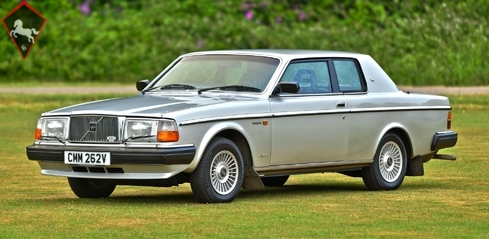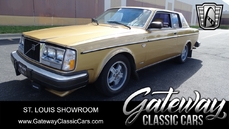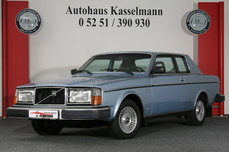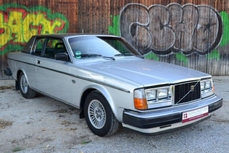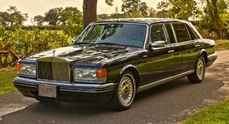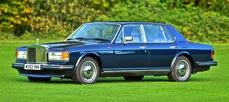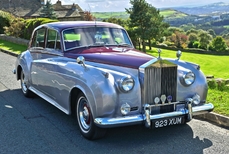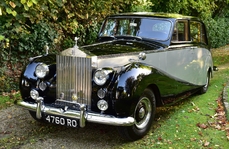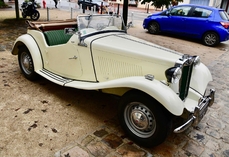Volvo 262 Bertone Bertone Coupe Automatic. 1979
General description :
1979 Volvo 262 Bertone Coupe Automatic.
Registration number: CMM262V
A very rare car of which some 6000 examples were made with most being experted to the USA. This example was UK supplied & is finished in immacualte silver metallic paintwork, the only colour available at first although Gold became an option later. This example is in superb order thoughout having covered 89000 miles from new & resided in a small private collection of unusual cars.
This car drives beautifully & has a solid feeling typical of the Volvo Brand. The interior is swathed in Black leather & burr walnut. Carpets that one might more usually find under foot are also used to cover the ceiing as a roof lining. The lusty V6 engine starts readily & provides plenty of go augmented by the three speed with overdrive automatic gear box.
Presented in very fine overall condition, this rare & collectable Volvo Coupe is ready for immediate use.
Volvo's Heritage side tells us the following:
Launched at the Geneva Motor Show in March 1977, perhaps the most unexpected Volovo model version saw the light of day: a two-door coupé with heavily slanting windscreen pillars and the roof lowered by 60 mm. To get the car to be perceived as sleeker, the rear spare wheel pods had been removed - the remainder of the body was identical.
What really made the 262C into what it was could be found in the passenger compartment. This offered an extravagance of leather and hardwood. The seats, headrests, door sides - even the curve handles had been upholstered in leather. When the Volvo 1800ES was discontinued in 1973, there was no natural successor to the role of top range sports model. Volvo’s CEO Pehr G Gyllenhammar saw this as a problem. It was especially important that there was a model of this kind in Volvo’s biggest export market in the USA and a luxury coupé seemed more right at the time than another sports car. Volvo’s chief designer Jan Wilsgaard did sketches for the shapes of the prestige car, but no clay model was ever built. Instead, he used a Volvo 164 that had been used to test new interiors. It was taken to the Italian designer Sergio Coggiola’s company in the Italian city of Turin, where the four-door body was rebuilt into a two-door body with a lower roof. The roof was clad with vinyl and the wide C-pillar adorned with three crowns - Sweden’s heraldic national symbol. The three crowns were replaced with one larger one on the production car, which is one of the very few differences between it and the prototype - except the obvious one that it was based on a 164. The engine in the 262C was initially a 2.7 litre, 140 hp V6. It was shared with all the other body versions in the 260 series and had been developed together with Peugeot and Renault. Manufacturing took place in Douvrin in France under the auspices of the Société Franco-Suédoise de Moteurs-PRV company. Volvo’s engine designation was B27E and thanks to engine blocks and cylinder heads made from aluminium, it weighed less than 150 kg. Such a niche product, built in small numbers, didn’t fit into the Volvo plant in Gothenburg. Instead, final assembly took place at the Italian Carozzeria Bertone, who also built the 264TE limo. Kits were sent to Turin where the bodies were modified, painted and assembled into finished cars. A small badge on the lower part of the front fenders showed that Bertone had built the car. For the first few years, the 262 was only available in silver metallic with a black vinyl roof. From 1979, it was also available in gold metallic without a vinyl roof. That year, all saloon models in the 200 series also received a new rear with a boot that went down at the rear edge. The tail lights were also new and went around the body corners. In 1980, black and light blue metallic and silver metallic with vinyl roof was phased out. In the USA, the model was sold under the name of the Volvo Coupé from 1980. The model year that stands out the most was also its last. In 1981, the 200 series underwent a major update with new, more slender bumpers and a new headlight set up. The B27E became a B28E as the engine gained in terms of cylinder volume and had another 14 horsepower added to it. The new colour combination was a two-tone paint job in gold and nougat. The aim was to manufacture 800 units per year, but expectations for demand had been set far too low. Apart from in 1977 when production started late in the year, and the final model year, production figures were more than double the forecast. When the final cars were sold in 1981, they were already considered to be collectibles. In total, 6,622 cars were built between 1977 and 1981.
1979 Volvo 262 Bertone Bertone Coupe Automatic. is listed for sale on ClassicDigest in Essex by Prestige House for Not priced.
Car Facts
Car type : Car Make : Volvo Model : 262 Bertone Model Version : Bertone Coupe Automatic. Engine size : 0.0 Model Year : 1979 Sub type : Coupé Location : Essex Vehicle Registration : Undefined
Not priced
Seller Information
Vintage & Prestige
Prestige House
+44(0)1375 379719, +44(0)7967 260673
Prestige House
+44(0)1375 379719, +44(0)7967 260673
People who viewed this Volvo 262 Bertone also viewed similar Volvo listed at ClassicDigest
Other cars listed for sale by this dealer
About Volvo
Volvo has a rich history spanning over nine decades, marked by a commitment to safety, innovation, and Scandinavian design. Here's an overview of Volvo's evolution, including key models and the design and technological highlights leading up to the XC70:Early Years and Foundation: Volvo was founded in 1927 in Gothenburg, Sweden. The first Volvo car, the ÖV4 (Jakob), rolled off the production line in 1927. Volvo quickly gained a reputation for producing sturdy and safe vehicles.
Safety Innovations: Volvo became synonymous with safety innovations. In the 1950s, they introduced the three-point seatbelt, a groundbreaking invention that became standard in automobiles worldwide. Over the years, Volvo continued to pioneer safety features such as crumple zones, rear-facing child seats, and side-impact protection.
Design Evolution: Volvo's design philosophy evolved, blending Scandinavian simplicity, functionality, and safety. The brand's design language embraced clean lines, robustness, and a focus on interior comfort.
Key Models Through the Years:
Amazon (120 Series): Introduced in the late 1950s, the Volvo Amazon featured elegant styling and became popular for its reliability and safety features.
140 Series: Launched in the 1960s, it showcased Volvo's focus on safety and introduced innovations like disc brakes.
240 Series: Introduced in the 1970s, the 240 became an iconic Volvo model known for its durability, safety, and boxy design, remaining in production for nearly 20 years.
850 Series: In the 1990s, Volvo introduced the 850, known for its innovative features, including the first front-wheel-drive model with a five-cylinder engine.
XC70 Series: The XC70 debuted in the early 2000s as an off-road variant of the V70 wagon. It combined Volvo's renowned safety features with all-wheel-drive capability and a higher ground clearance for enhanced off-road performance.
XC70 Design and Tech Specs: The XC70 epitomizes Volvo's dedication to safety, versatility, and Scandinavian design. Some design and technical highlights include:
Robust and functional design with protective cladding and raised ground clearance for an SUV-like appearance.
All-wheel drive (AWD) system for better traction on various terrains.
Advanced safety features, including Volvo's City Safety system, which helps prevent collisions in urban traffic situations.
High-quality interior with comfortable seats, ample cargo space, and modern infotainment and connectivity options.
